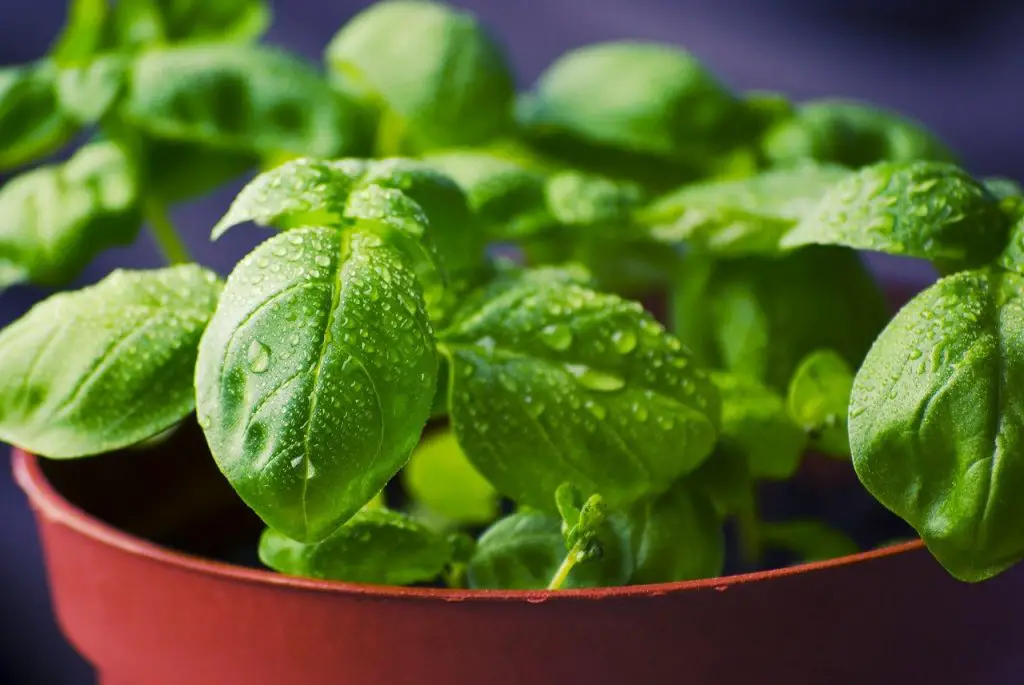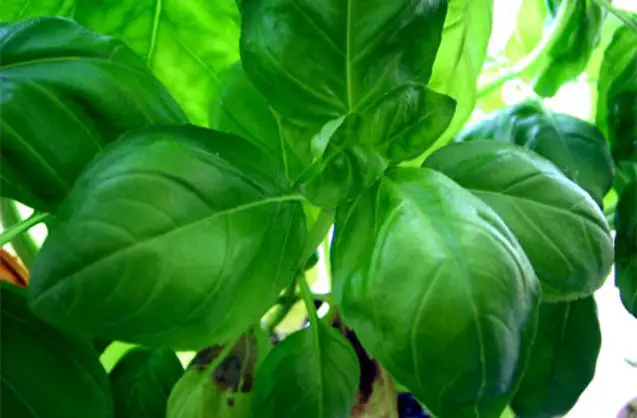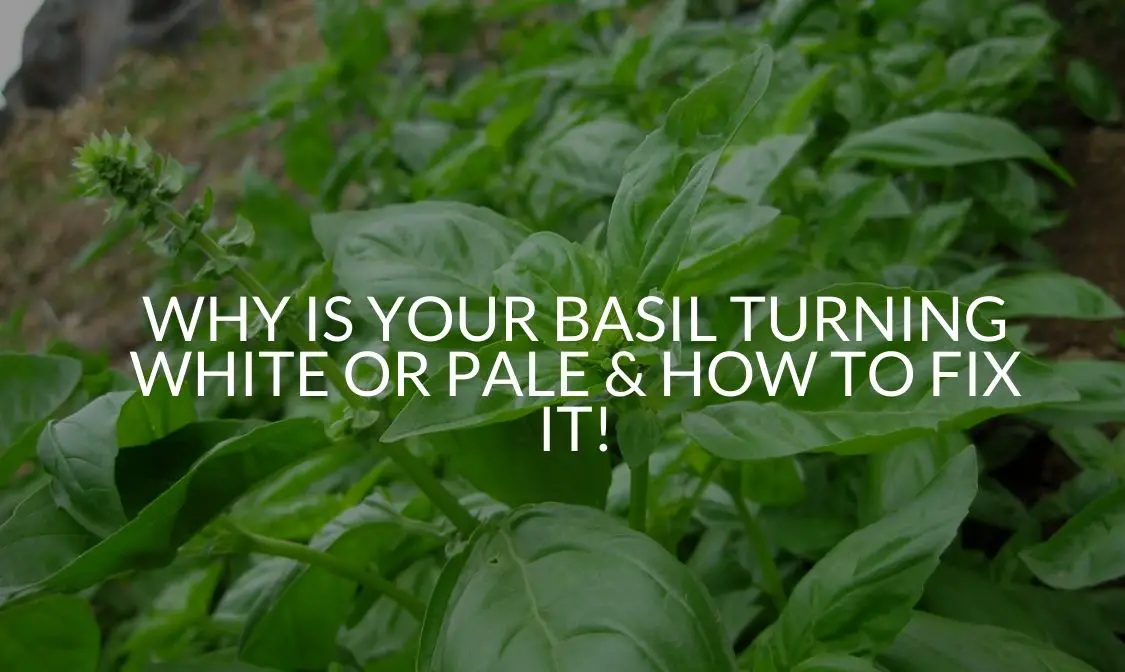Whether you are a person who loves gardening, or one who simply wants to use to produce organically grown in their homes, you may find yourself tending to a basil plant. If you’re wondering why are your basil leaves turning white, look no further.
Basil leaves are considered easy to grow at home, however, there are certain things that you need to know in order to ensure your basil plant is healthy and happy.
What are Basil Plants?
Before you can successfully tend to a basil plant it is a good idea to take a minute to understand what a basil plant really is.
Scientifically called ‘Ocimum basilicum’, basil is distinctly known for its aromatic leaves and thus widely used as a kitchen herb. Basil is an herb often used as an ingredient to prepare a wide range of food items such as meat, salads, pasta, and sauces. There are also some people who like to have basil tea due to its stimulant qualities.
Basil plants are woody plants that have glossy, rounded leaves that have a tendency to form the shape of a cup. It sports a growth of flowers in bunches whose color range extends from pure white to a distinct magenta.
Though there are many strains of basil available, it is commonly considered to have originated in the warm regions of India. Due to this particular fact it is not hard to believe why the basil plant is extremely sensitive to cold, and frosty weather conditions.
Why Are Your Basil Leaves Turning White?
As mentioned previously, basil leaves are extremely sensitive to the external environmental conditions. If your basil plant is developing odd color patterns, it generally means that the plant is alerting you about a condition that is less than ideal for the plant itself.
If you have noticed that your basil plant’s leaves are changing their color into white spots or shade, you are on the right track. Your next step will be to figure out the reason why this is happening.
Basil plants often develop white spots on their surface when they are exposed to extremely hot temperatures or are facing direct sunlight. Bear in mind that basil plants generally grow better in full sunlight, unless the external temperature is really high. In that case, basil plants thrive in places where there is a partial shade.
The color change from green to sickly white indicates a degeneration of the chlorophyll in the plant’s leaves. This phenomenon often occurs when the basil plant is placed in sunlight too early and exposed to the harsh rays of the sun, especially when they are kept outdoors.
Young basil plants are more likely to be effected by the intense heat as their very structure has not yet developed the protective woody stems of an adult plant.

How To Treat Basil Leaves Turning White
If you have noticed that your basil leaves are turning white, it means that all you have to do is to evaluate the surrounding conditions to see what may be affecting the plant. Since whitening leaves or basil leaves that are developing white spots are usually caused due to exposure to extreme sunlight or heat, it is a good idea that you consider moving your plant into a place where there is some shade.
You can either move your plant indoors or keep it in a shady outdoor spot such as a porch or a veranda. Remember that if you choose to move your plant indoors you would have to reduce the amount of water you give it as the transpiration rate would decrease indoors.
Why Is Your Basil Losing Color?
The basil plant has thus been established as a plant that is extremely susceptible to changes in its external environment. Changes in the color of the basil plant indicate surrounding excesses or deficiencies that are affecting the well-being of the plant. Basil plants experience a change in color, typically to a pale yellow, due to a large array of varying reasons.
If you have noticed a color change, it is a good idea to evaluate the external conditions of the plant and then consider if your plant may be affected by one or more of the following reasons.
Too Little Sun
If you live in a region of moderate to low temperatures and choose to keep the basil plants in a shady area outdoors, or even as an indoor plant, chances are that your plant suffers from a lack of sunlight. A slow rate of photosynthesis or even transpiration would cause the plant to wither and its leaves to turn yellow.
Incorrect Watering
One of the most common reasons of yellowing basil leaves is excessive watering. Giving the basil plant a superfluous amount of water can result in a phenomenon known as ‘root rot’. As its name suggests, root rot refers to the condition when the basil plant’s roots turn a dark brown or black color and take up a mushy texture.
Wondering why your Basil Plant is turning yellow? Click here to find out why and what to do about it!
The root rot interesting affects the leaves of the basil plant, making them turn yellow starting from the lower leaves (which are nearer to the roots) and moving on upwards to eventually engulfing the whole plant.
The Presence of Pests
One of the most frustrating things for people trying to keep their basil plants healthy is the battle with pests. There are many kinds of pests that can seriously affect and hinder the growth of a basil plant, as pests can cause a variety of problems for the plant such as the stealing of essential nutrients.
- Caterpillars: one of the most common pests is the seemingly innocuous caterpillar. These pests are known to feed upon basil subsequently causing foliar harm to the plant itself.
- Aphids: these are extremely small pests that can be found under the leaves of an infested basil plant. The pests are responsible for extracting the juice from the plant’s foliage, causing its leaves to turn yellow.
- Root-knot nematodes: as their name suggests, these pests live within the soil of basil plants, causing a condition known as ‘root galls’. Their presence thus is that which facilitates the yellowing of the basil leaves.
Look Out for Disease
Some basil plants are more prone to developing disease than others. One of the most common sources of disease is through the presence of fungi. There are a variety of fungal diseases that can cause the yellowing or de-coloring of basil plant leaves.
Downy Mildew is one of the most recurring fungal disease to plague basil plants. This fungal infection is characterized by a kind of fuzzy fungal growth that is in varying shades of brown and gray, which causes the leaves to turn yellow.
Lack of Nutrients
Though basil plants don’t require many nutrients, having a lack of nutrients in the soil can affect their growth can cause a yellowing of their leaves. Nitrogen deficiency in the soil is one of the prime reasons for yellowing basil leaves.
How To Treat Basil Leaves Losing Color
There are numerous ways to treat a basil plant that is losing color in its leaves. It is essential that you bear in mind that your treatment depends upon the condition affecting the plant.
For example, if your basil plant is turning yellow due to lack of proper sunlight, spraying it with pesticides will not solve the problem. It is important that you first identify the issue with your basil plant in order to deal with it effectively.
There are also some people who suggest that you position your basil plants in a controlled environment such as a greenhouse where you can give it the right atmospheric conditions to thrive.
Repositioning the Basil Plant
If you realize that your basil plant is being affected by its positioning, it is a good idea to move your plant outdoors where it can enjoy the sunlight. Keep in mind that if you live in a place where the sun rays are extremely strong, it is a good idea to keep the basil plant in a place of partial shade to protect it from extreme exposure to heat and sunlight.
Regulating the Plant’s Water Supply
As explained previously, over-watering a plant, especially over a certain amount of time can be extremely harmful for a basil plant as it results in a condition called ‘root rot’. In order to control the root rot, it is important that you make sure you regulate the amount of water that you expose your plant to.
If you’re wondering how much water exactly is enough for a basil plant, you need to keep in mind that the plant’s soil should be damp instead of being soggy. The ideal soil condition for a basil plant is that three centimeters (one and a half inches) of the soil should be dry. Basil plants which have slightly dry soils are healthier than those plants whose soils are waterlogged.
Additionally, to ensure that there is no excess of water for your basil plant, you can make sure that the container or flower pot has a hole in the bottom for drainage.
Treat the Pests
It requires patience to deal with pests in plants, but the effort pays off when the plants grow healthy. Here are some pest-specific ways to help you control infestations in your basil plants.
- Caterpillars: you can either physically remove the caterpillars from the basil plant or even choose to apply a strain of natural bacteria called ‘Bacillus thuringiensis’.
- Aphids: there are many insecticides that effectively control aphid populations on basil plants. However, make sure not to apply insecticides under direct heat or sunlight as it may burn and harm the leaves of the plant.
- Root-knot Nematodes: these require some skill to get rid of. It is recommended that you harvest the basil plant, only using the healthier leaves as this would ensure that future growth would be resistant to the nematodes.
Control the Spread of Disease
You can treat basil plants that have been infected by fungal diseases such as Downy Mildew by carefully removing the areas of infestations with some sharp gardening scissors. Bear in mind that if the fungal disease has spread across the whole plant it is a good idea to remove and carefully dispose of the plant in order to contain the disease.
Replenish Soil Nutrients
One of the best ways to restore the soil’s nutrients is to make the careful use of natural fertilizers. The best fertilizer would have a balanced nutrient content and is suited for all kinds of plants. Compost, cotton-seed meal, or even blood-meal are good ways to encourage healthy basil growth.

FAQ
Can You Eat Basil Leaves Turning White?
If your basil has white spots on its surface, you can still eat it provided that you cut the spotted area out of the leaf. Moreover, it is important that you remember to wash the leaves thoroughly with warm water to ensure that consuming it won’t harm you.
Is There Any Part Of A Basil That Is Poisonous?
Basil is a kitchen herb which means that you consume any part of it without fearing any negative side-effects. Note that after a basil plant flowers, it’s taste becomes slightly more bitter, nevertheless it is still edible.
Recap
If you notice that the leaves of your basil plant are turning white, usually it is because the chlorophyll of the plant is affected by the intense heat and sunlight in the atmosphere. You can simply move your plant indoors or place it in a shady place to restore the plant to its vitality.
There are many other factors that can also reduce the colors of your basil plant such as lack of sunlight, excessive watering, the presence of pests and disease, along with a lack of nutrients in the soil.
There are many different ways to treat the condition of dull or yellowing basil leaves, which depend upon the malady that affects it. Thus, it is essential that you figure out what is ailing your plant before attempting to treat it.
Hope this helps!
Sources
- https://www.britannica.com/plant/basil
- https://ask.extension.org/questions/393197#:~:text=The%20color%20change%20means%20the,the%20heat%20of%20the%20sun.
- https://www.gardeningknowhow.com/edible/herbs/basil/yellow-leaves-on-basil.htm
- https://www.thespruce.com/how-to-grow-basil-plants-1402624
- http://realestate.boston.com/ask-the-expert/2018/09/24/how-to-fix-yellow-basil/#:~:text=There%20are%20three%20reasons%20why,10%2D10%2D10%20fertilizer



